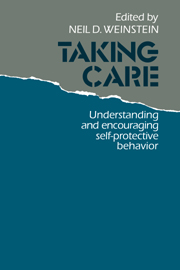Book contents
- Frontmatter
- Contents
- List of contributors
- Acknowledgments
- Introduction: studying self-protective behavior
- I Theoretical perspectives
- II Research and prevention programs for specific hazards
- 6 Why people take precautions against health risks
- 7 Community studies of smoking cessation
- 8 Preventing adolescent smoking
- 9 Natural hazards and precautionary behavior
- 10 Programs that encourage the adoption of precautions against natural hazards: review and evaluation
- 11 Why people take precautions against crime: a review of the literature on individual and collective responses to crime
- 12 Promoting citizen involvement in crime prevention and control
- 13 Injury prevention: limits to self-protective behavior
- 14 Perspectives on protective behaviors and work place hazards
- III Conclusion
- Index
12 - Promoting citizen involvement in crime prevention and control
Published online by Cambridge University Press: 03 February 2010
- Frontmatter
- Contents
- List of contributors
- Acknowledgments
- Introduction: studying self-protective behavior
- I Theoretical perspectives
- II Research and prevention programs for specific hazards
- 6 Why people take precautions against health risks
- 7 Community studies of smoking cessation
- 8 Preventing adolescent smoking
- 9 Natural hazards and precautionary behavior
- 10 Programs that encourage the adoption of precautions against natural hazards: review and evaluation
- 11 Why people take precautions against crime: a review of the literature on individual and collective responses to crime
- 12 Promoting citizen involvement in crime prevention and control
- 13 Injury prevention: limits to self-protective behavior
- 14 Perspectives on protective behaviors and work place hazards
- III Conclusion
- Index
Summary
Introduction
Crime and the fear of crime are high on the list of public concerns. The reality of the problem is reflected in Department of Justice figures indicating that more than one household in four will experience a serious crime during the year (Bureau of Justice Statistics, 1986). Violent crimes are, in fact, more frequent than many other serious life events. For example, the risk of being a victim of a violent crime is greater than the risk of injury in an auto accident, injury or death from a fire, or death from heart disease or cancer (Bureau of Justice Statistics, 1983).
Fear of crime is often linked to fear of victimization by a stranger, as in robbery and burglary, crimes that have shown dramatic increases in the past 20 years. The reported robbery rate, for example, increased 400% between 1960 and 1978, with 65% of these crimes involving armed offenders (National Institute of Justice, 1983). The rate of burglary has also increased significantly, recent national crime surveys indicating an annual rate of 1 of every 11 U.S. households.
Although the problem of crime has usually been seen as the responsibility of the criminal justice system, increased attention is being given to the contribution that citizens can make to their own security.
- Type
- Chapter
- Information
- Taking CareUnderstanding and Encouraging Self-Protective Behavior, pp. 254 - 279Publisher: Cambridge University PressPrint publication year: 1987



